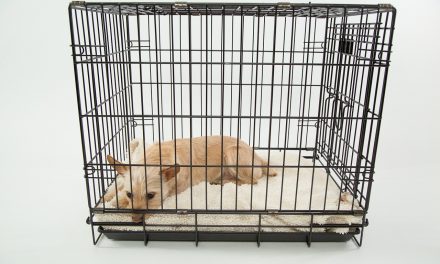There are many reasons why someone might choose to crate their dog at night, and there are still some people who think that crating a dog is outdated and cruel. Crating a dog at night or during the day for that matter is not cruel. When used correctly, dog crates can be a valuable tool when starting to train your dog.
Of course, if you left a dog locked in the crate all day and all night, there is no doubt that it is cruel, but using it at specific times of the day or night can be hugely beneficial in teaching your dog acceptable behaviours, and to keep them safe.
Throughout history, with wild and even domestic dogs, it has been shown that they do not like to sleep out in the open, they will choose to make themselves a den that they will retreat to. Crates are no different from any other den except that they have a door that we can close.
If given a choice, a domestic dog will choose to sleep in the crate even when the door is left open. We have two dogs, and we use a crate for feeding times as both of mine are food dominant and will fight over food. The door on our crate is left open for the rest of the time, and both of them like to sleep in there at different times of the day.
My female has mainly chosen the bottom of the kitchen pantry for her den. No one forces her to sleep in there; she just went in there one day, and she’s been sleeping in there ever since. Since the introduction of the crate they take it in turns using it, one will sleep in the pantry while the other sleeps in the crate and they do it because they want to.
What to expect from our article
Other reasons to crate train
There are many other reasons to crate train a dog and teaching a dog that a crate is a safe place can be essential not just within the home.
Travelling
A crate is handy when travelling, as it can be an extremely stressful experience for a dog, especially with dogs who have a predisposition of nervousness. A nervous dog can experience so much stress while travelling that it can pee or poop, and some dogs just like humans can experience travel sickness and will vomit while travelling in the car.
A crate can not only be used as a safe space which will have a calming effect on the dog when travelling, but it will also help to contain any accidents that may occur and trust me when I tell you it’s not fun cleaning up sick and diarrhoea off of car seats.
We had a dog years ago who didn’t like travelling in the car. This particular time I was by myself and I popped her in the boot as usual, and off I went. Something spooked her, and she managed to climb over onto the back seat, it wasn’t until the smell hit me did I know what was coming next, oh how I wished I had her crated.
Visiting the vet
We all know that visiting the vet for any reason can be a stressful experience for a dog, the sights, sounds, and even encountering new people can cause a dog to act out. Obviously, if you have a large dog using a crate to transfer a dog from the car and into the surgery isn’t something that can be done easily, but smaller dogs can be kept in the crate and taken in no problem.
Something else you may not have thought about is what would happen if your dog needed to have surgery? If your dog did need to stay at the vet’s for a prolonged period, they would need to be put in a crate during that time. Introducing a dog to a crate early on will be beneficial if they needed to be put in one in the future. If your dog needs to have an operation for any reason, then recovery will be a lot easier if the dog is confined to a smaller space, especially if they have to be immobilised. If you are able to use a crate, they won’t be able to run around and cause further injury.
Time out
Just like a baby, a puppy needs to be put down for a nap now and then, not as a punishment but for it to be able to calm down. What we see as naughty behaviour, nipping, running around like the Tasmanian devil ETC is not actually naughty behaviour it is usually because the puppy is tired but is refusing to go to sleep.
Too much stimulation is not good for a puppy who is learning to behave correctly, putting the puppy in a time out in the safety of a crate can help them to recognise when he or she is tired and enable them to calm themselves down without being reprimanded.
This scatty behaviour may seem cute when they are puppies, but imagine what that behaviour will be like when they are fully grown. If the puppy is not subjected to the proper training when they are small, he/she will continue with the unwanted behaviour into adulthood. Many dogs are surrendered to shelters because owners allowed cute puppy behaviours to grow into adult dogs and are no longer able to cope with them.
The crate should never be used as a punishment as the puppy will see the crate as a prison rather than a safe place. Adding some blankets, treats and some of your puppies favourite toys will allow the puppy to see it as a safe place where it can be calm and sleep without being disturbed. For more information on crate training, see our guide on how to crate train your dog.
How to introduce a dog to a crate
It is essential to introduce the crate gradually; you should start by setting it up in the room that your dog uses the most. Allow the dog or puppy to become acquainted with it before attempting to put them in it. You may find that more adventurous, outgoing dogs will be eager to check it out and may even climb right in. nervous dogs will no doubt be standoffish and wary of this new intruder.
Once your dog has gotten used to the crate being in the same room as them, and they start to investigate, you can pop a blanket and some of their favourite toys in it. Observe how the dog reacts around the crate, are they inquisitive? Are they nervous or scared? These are all hints on how slow or how quickly you can progress with the crate training.
If the dog is nervous or scared, then you will need to take your time getting them used to it, spend time sitting near the crate and try to make the experience fun so that your puppy/dog becomes less aware of it.
You can give them treats when they go near to it, put their food bowl next to it and even groom them next to it. We want to show them that it is safe to be around the crate, which means they will be more likely to accept being put in it. Never try to force a dog or puppy into a crate as this will result in a negative association making it extremely difficult for them to accept it.
If your dog is happy to be around the crate, then you can start to introduce them to the inside. This is the fun part, get your dogs favourite toy and instigate a game with them, once you have the dog interested in the toy, you can toss it into the crate and see if they climb inside. Some dogs might be happy to go straight in; some may put their head in grab the toy and run away.
It is essential to let the dog do everything at their own pace. If the dog is not interested in retrieving their toy from the crate, then you will need to step it up a little, try using their favourite treats. Toss a treat just inside the crate so it can easily be reached. Keep doing this until the dog shows no signs of being nervous.
Once he/she is putting their head in without any issues, you can put the treat in a little bit further each time; once they have climbed completely into the crate you can start to shut the door, but don’t lock it, let them know that they can leave the crate at any time. The first time you lock the door on the crate, you should give them a treat that is going to last a little longer, like a chew toy or a juicy bone we want to take the emphasis off the fact that the door is locked.
You can extend the time you leave the puppy or dog in the crate for a few minutes at a time if the dog is happy to be in the crate with the door shut then you have succeeded with training, and you shouldn’t have any further problems when using it. You should find that most dogs will accept the crate pretty quickly without any issues. If the dog or puppy is not happy with the door being shut, then you need to extend the training time.








